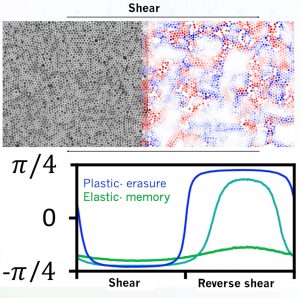
(Top left) Particle suspension subjected to cyclic shear.
(Top right) Color code indicating where memories are being lost (red and blue) and where they are retained (white).
(Bottom) Reading of memories. The original microstructural orientation (−𝜋∕4) is retained during elastic response. During a plastic response microstructural orientation switches.
A disordered material’s structure and macroscopic mechanical response are related in a non-trivial way. By studying a 2D jammed colloidal system under oscillatory shear, our study elucidates this link in the transition from elasticity to plasticity based on microstructural signatures. We find that elasticity is accompanied by retention of orientation within the particle arrangements; even as the shear reverses, the orientation endures. As plasticity emerges, the orientation reverses along with shear. This fundamental observation has allowed us to describe the rheology of the yield transition based on the microstructure. We have:
- Related excess entropy, a thermodynamic quantity, to plastic dissipation.
- Described yield using entropy harmonics and memory signatures.
- Developed a physically informed model that describes the yield transition, where all variables are measured.
